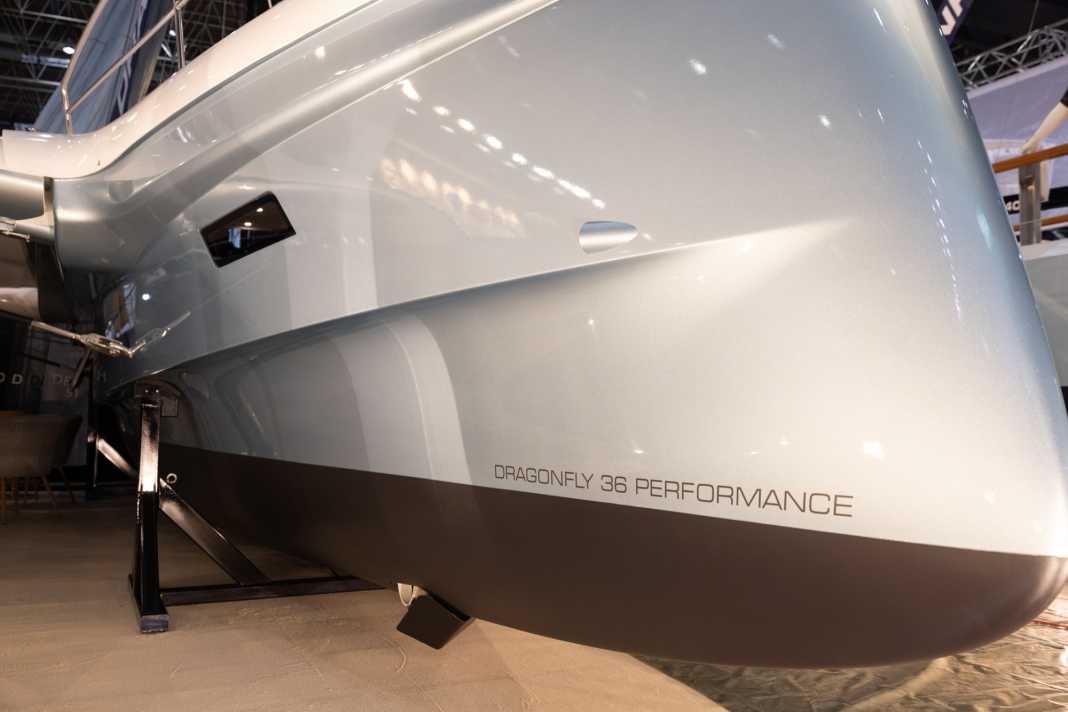boot Düsseldorf Premieres IV: Dragonfly 36 - the fastest boat of its size?






No, this is not déjà vu. At first glance, you might think that the new Dragonfly is another version of the last Dragonfly presented. 40-foot model. But the side view of the centre hull makes it clear that the impression is deceptive, because the new design has a negative wave piercer stem there, just like on the floats.
The boat has a fixed, 90-centimetre-long bowsprit to which the Code Zero or gennaker can be attached. The nose also serves as a mount for the anchor, which has to be positioned particularly far forward of the hull due to the wave piercer bow to prevent damage to the GRP.
The large cockpit is equipped with two steering wheels. All lines are led to four electric winches at the rear of the cockpit so that the Tri can be sailed single-handed. The Tri should therefore appeal to sporty cruising and single-handed sailors as well as being suitable for regattas such as the Fünen Rund. The shipyard forecasts a maximum speed of 23 knots. This would make the 36 just one knot slower than the 40-foot top model of the Danes.
Two versions for different needs
The Dragonfly 36 is built as a touring version and in a performance version. Both versions have a carbon mast, but they differ in their sail configurations.
Touring version
The touring version is ideal for sailors who value easy handling. It is equipped with a self-tacking jib and has a 16.50 metre mast.
Performance version
If you want more action, the Performance version comes with a two metre higher mast and a larger overlapping furling genoa as well as significantly more sail area overall. The Code Zero alone increases by around 13 square metres. The gennaker even grows by 40 square metres.
The construction of the hulls and the weights of both versions are identical.
Composite instead of steel - innovative folding mechanism
With the help of the SWING WING system typical of Dragonfly-Tris, the width of the 36 can be reduced from 8.12 metres to just 3.7 metres for mooring. The sophisticated mechanics are operated with an electric winch and the new model is the first to feature a fully composite construction. Computer simulations and physical strength tests were carried out for optimisation.
The elimination of stainless steel hinges means that forces can be better transferred to the hull; the shipyard also claims that the design is lighter, more stable and easier to maintain.
Comfort below deck
The interior is finished in ash wood as standard, with elm veneer also available as an option.
The interior comprises double cabins in the bow and aft area as well as a separate washroom between the foredeck and saloon. The galley is located directly at the companionway, with a small navigation table opposite.
Like previous models, the centre hull has a two-part design. Below the waterline, the width is deliberately kept slim to minimise drag. In addition, the width increases significantly, which allows for larger berths and more living comfort.
Pricing
The base price ex shipyard is quoted at 495,000 euros excluding VAT. This means that the Dragonfly 36 is no bargain. However, the standard boat also includes a range of equipment that is usually subject to an additional charge, such as the electric winches and the carbon rig. The structural loads that occur in fast trimarans also require more complex laminates, which means that the prices are not directly comparable with monohull yachts.
Technical data of the Dragonfly 36
- Design engineer: Olsen Design / Quorning Boats ApS
- Torso length: 11,55 m
- Width: 8,12 m
- Width with retracted floats: 3,70 m
- Draughts: 0.67 m (min.) / 2.00 m (max.)
- Weight ready to sail: 4,5 t
- Mast height: 16.5 m (touring) / 18.50 (performance)
- Mainsail: 60,0/70 m2
- Genoa: 30,0/38,5 m2
- Self-tacking jib: 20,0/25,0 m2
- Gennaker: 110/150 m2
- Code Zero: 60/72,5 m2
- Engine30 Ps /21.3 kW
This might also interest you:
- Cruising in Denmark with the Dragonfly 28
- Cape-WT40: Light trailer tri from England
- Rapido 40: Lightweight trimaran from Vietnam. The test
- Dragonfly 40: The full test report at YACHT online
- Corsair 760: Attractive folding runner on the test bench
- Playground on the water: testing the Astus 22.5
- Carbon rocket: Black Marlin

